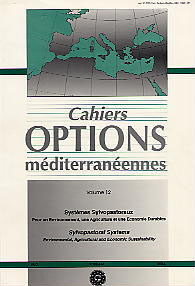| Article précédent | p. 259-262 | Article suivant |
Evolution of the tree cover (Quercus pyrenaica Willd and Quercus ilex subspecies ballota (Desf. Samp)) in a dehesa over the last 100 years
During the first 60 years, the decrease in the numbers of both the holm-oak and the oak was due to tree felling. The first 6 years were devoted to tree felling and cut clearing in order to clear dense forest with a view to transforming it into pasture and farmland; during the next 54 years the cut trees were used as a source of heat for the home and of wood for construction and the making of farming tools and diverse utensils. 2. Tree felling has gradually declined over the last 40 years (it has almost disappeared) as the use of wood has been replaced by gas and gas-oil for fuel and iron and cement for construction. However, the mortality rate has increased. The deaths are mainly the result of the effects of the xylophagous insects (its effects are not usually lethal to trees under 100 years old) and other as yet undetermined causes, perhaps of drought. 3. In stands 2 and 3 (N orientation) agriculture benefited the old oak, which developed on the fringes and rocky outcrops and immediately invaded the territory as soon as the cultivation of cereals was stopped. A similar phenomenon occurs in the SW orientation with the holm-oak. 4. Autochthonous livestock (mainly cattle) on an extensive free range basis impedes the recovery of oak density, eliminating almost all of the youngest ones in the underbrush and shrub phases, when their diameter in the first meter of height is less than 9 cm. It does not eliminate the holm-oaks, but greatly retards their growth. When young holm-oaks are taller than 2 m, they can also be broken by domestic livestock if they do not reach a diameter of 6 cm in the first meter. 5. The end result is a rapid and dramatic decrease in tree-cover.
- [ Afficher ]
- [ Télécharger ]
- [ Exporter la citation ]
Vous pouvez télécharger la citation au format :
- [ Imprimer ]
-
Mots-clés
BETAIL, QUERCUS ILEX, QUERCUS PYRENAICACiter cet article
Pérez-Fernández M.A., Gómez-Gutiérrez J.M. Evolution of the tree cover (Quercus pyrenaica Willd and Quercus ilex subspecies ballota (Desf. Samp)) in a dehesa over the last 100 years. Systèmes sylvopastoraux. Pour un environnement, une agriculture et une économie durables . Zaragoza : CIHEAM, 1995. p. 259-262. (Cahiers Options Méditerranéennes; n. 12). Réunion du Groupe de Travail Méditerranéen du Réseau Interrégional FAO/CIHEAM de Recherche et Développement sur les Pâturages et les Cultures Fourragères, 1995/05/29-1995/06/02, Avignon (France). http://om.ciheam.org/om/pdf/c12/96605533.pdf



